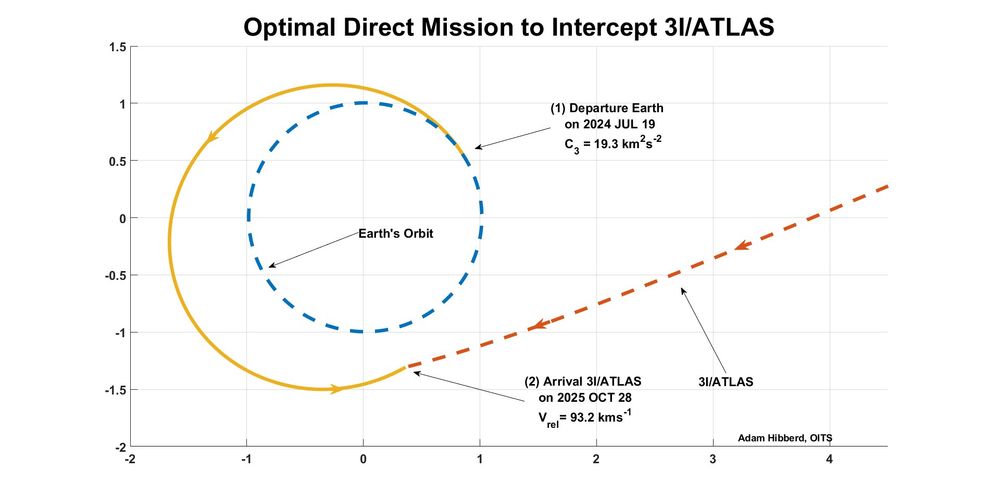
Adam Hibberd
@adamsspaceresearch.bsky.social
I developed the software which was used to solve the problem of catching up with the first interstellar object to be discovered, 1I/'Oumuamua, Project Lyra. I am a researcher for the Initiative for Interstellar Studies (i4is).
The optimal direct intercept launch date has elapsed (2024 July 19th launch), but an indirect route, using some combination of gravity assists, might be able to get there. Just looking into this.
@i4interstellar.bsky.social
@i4interstellar.bsky.social

July 4, 2025 at 5:20 PM
The optimal direct intercept launch date has elapsed (2024 July 19th launch), but an indirect route, using some combination of gravity assists, might be able to get there. Just looking into this.
@i4interstellar.bsky.social
@i4interstellar.bsky.social
At the moment I am immersed in the study of missions to Potentially Hazardous Asteroid (PHA) 2024 YR4.
Using my software 'Optimum Interplanetary Trajectory Software' (OITS), I have discovered plenty of viable flyby missions, sample return missions and rendezvous missions.
Using my software 'Optimum Interplanetary Trajectory Software' (OITS), I have discovered plenty of viable flyby missions, sample return missions and rendezvous missions.


February 9, 2025 at 8:54 AM
At the moment I am immersed in the study of missions to Potentially Hazardous Asteroid (PHA) 2024 YR4.
Using my software 'Optimum Interplanetary Trajectory Software' (OITS), I have discovered plenty of viable flyby missions, sample return missions and rendezvous missions.
Using my software 'Optimum Interplanetary Trajectory Software' (OITS), I have discovered plenty of viable flyby missions, sample return missions and rendezvous missions.
The dark bands indicate the solution space whereby a sample return mission can be realised, or alternatively a target return which would lead to the probes returning to the asteroid in 2032, that's 4 years after their initial encounter with it in 2028.

February 5, 2025 at 1:51 PM
The dark bands indicate the solution space whereby a sample return mission can be realised, or alternatively a target return which would lead to the probes returning to the asteroid in 2032, that's 4 years after their initial encounter with it in 2028.
This Colour Contour map indicates launch dates and appropriate arrival dates for direct missions to potentially hazardous asteroid (PHA) designated 2024 YR4.

February 5, 2025 at 1:51 PM
This Colour Contour map indicates launch dates and appropriate arrival dates for direct missions to potentially hazardous asteroid (PHA) designated 2024 YR4.
I feel I must discard all my modesty and British reserve, and advertise this ResearchGate achievement, albeit quite a small one, but personally a very welcome early Christmas present!

December 20, 2024 at 8:08 PM
I feel I must discard all my modesty and British reserve, and advertise this ResearchGate achievement, albeit quite a small one, but personally a very welcome early Christmas present!
I've been busy with the Grand Tour.
The Solar System has loads of asteroids, most of them reside in the Asteroid Belt and go around the Sun between the orbit of Mars and Jupiter. But some stubbornly refuse to conform to this pattern and wander off the beaten track.
The Solar System has loads of asteroids, most of them reside in the Asteroid Belt and go around the Sun between the orbit of Mars and Jupiter. But some stubbornly refuse to conform to this pattern and wander off the beaten track.
December 3, 2024 at 9:06 PM
I've been busy with the Grand Tour.
The Solar System has loads of asteroids, most of them reside in the Asteroid Belt and go around the Sun between the orbit of Mars and Jupiter. But some stubbornly refuse to conform to this pattern and wander off the beaten track.
The Solar System has loads of asteroids, most of them reside in the Asteroid Belt and go around the Sun between the orbit of Mars and Jupiter. But some stubbornly refuse to conform to this pattern and wander off the beaten track.
I've found at last from an initial number of 34665216 permutations of trajectory (a huge number of possible trajectories to visit 5 randomly chosen Near Earth Asteroids approaching close to Earth in 2030),
November 18, 2024 at 10:14 PM
I've found at last from an initial number of 34665216 permutations of trajectory (a huge number of possible trajectories to visit 5 randomly chosen Near Earth Asteroids approaching close to Earth in 2030),
Optimal trajectory to deflect Apophis should it actually be on a collision course with Earth in 2029, rather than swinging safely by as it is predicted to do.
November 17, 2024 at 6:50 AM
Optimal trajectory to deflect Apophis should it actually be on a collision course with Earth in 2029, rather than swinging safely by as it is predicted to do.
Look at these pork-chop plots created by my software development OITS. The colours are the minimum DeltaV (the darker the blue the better) to rendezvous with asteroid 2023 WK3, which has perihelion near Mercury's orbit and aphelion around Earth's. It's difficult but note the opportunity in 2039.


November 17, 2024 at 6:24 AM
Look at these pork-chop plots created by my software development OITS. The colours are the minimum DeltaV (the darker the blue the better) to rendezvous with asteroid 2023 WK3, which has perihelion near Mercury's orbit and aphelion around Earth's. It's difficult but note the opportunity in 2039.



